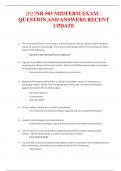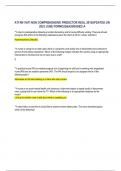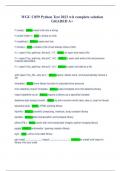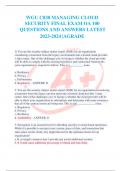Brendakarimi
On this page, you find all documents, package deals, and flashcards offered by seller brendakarimi.
- 15
- 0
- 0
Community
- Followers
- Following
15 items

The nurse assesses a patient with shortness of breath for evidence of long-standing hypoxemia by inspecting: A. Chest excursion B. Spinal curvatures C. The respiratory pattern D. The fingernail and its base D. The fingernail and its base Clubbing, a si
Which of the following endorsements must be attached to a standard Businessowners policy for coverage to apply to a businesses freezer that was damaged by the interruption of a power source --------- CORRECT ANSWER ----- Utility Services - Direct Damage endorsement. All of the following are criteria for an accident to have occurred "in the course of" the employment under a workers' compensation policy, EXCEPT: --------- CORRECT ANSWER ----- While performing a task that a fellow worker...
- Exam (elaborations)
- • 33 pages •
Which of the following endorsements must be attached to a standard Businessowners policy for coverage to apply to a businesses freezer that was damaged by the interruption of a power source --------- CORRECT ANSWER ----- Utility Services - Direct Damage endorsement. All of the following are criteria for an accident to have occurred "in the course of" the employment under a workers' compensation policy, EXCEPT: --------- CORRECT ANSWER ----- While performing a task that a fellow worker...

The nurse practitioner is reviewing a recent study that utilizes analytic epidemiology by means of a cohort study design. The cohort study design informs the practitioner about which of the following: • Outcomes that develop from an exposure. 2. A group o
The nurse assesses a patient with shortness of breath for evidence of long-standing hypoxemia by inspecting: A. Chest excursion B. Spinal curvatures C. The respiratory pattern D. The fingernail and its base D. The fingernail and its base Clubbing, a sign of long-standing hypoxemia, is evidenced by an increase in the angle between the base of the nail and the fingernail to 180 degrees or more, usually accompanied by an increase in the depth, bulk, and sponginess of the end of the fi...
- Exam (elaborations)
- • 4 pages •
The nurse assesses a patient with shortness of breath for evidence of long-standing hypoxemia by inspecting: A. Chest excursion B. Spinal curvatures C. The respiratory pattern D. The fingernail and its base D. The fingernail and its base Clubbing, a sign of long-standing hypoxemia, is evidenced by an increase in the angle between the base of the nail and the fingernail to 180 degrees or more, usually accompanied by an increase in the depth, bulk, and sponginess of the end of the fi...

TMN 3705 EXAM PACK 2023 LATEST UPDATE WITH CORRECT QUESTIONS AND ANSWERS
Behaviourism assumes a learner is essentially passive, and will be shaped through positive or negative reinforcement. Learning is therefore defined as achange in behaviour. Skinner (1974) believed that behaviour is a function of its consequences, i.e. learners will repeat the desired behaviour if positive reinforcement is given. The behaviour should not be repeated if negative feedback is given. Giving immediate feedback, whether positive or negative, should enable your learners to behave in...
- Exam (elaborations)
- • 39 pages •
Behaviourism assumes a learner is essentially passive, and will be shaped through positive or negative reinforcement. Learning is therefore defined as achange in behaviour. Skinner (1974) believed that behaviour is a function of its consequences, i.e. learners will repeat the desired behaviour if positive reinforcement is given. The behaviour should not be repeated if negative feedback is given. Giving immediate feedback, whether positive or negative, should enable your learners to behave in...

WGU C211 - Global Economics for Managers with complete solution 2022/2023 UPDATE
Views on Globalization - answer New, Evolutionary, and Pendulum "New" view on globalization - answer A force sweeping through the world in recent times. "Evolutionary" view on globalization - answer A long-run historical evolution since the dawn of human history "Pendulum" view on globalization - answer One that swings from one extreme to another from time to time Foreign Direct Investment - answer Direct investment in, control, and management of value-added act...
- Exam (elaborations)
- • 15 pages •
Views on Globalization - answer New, Evolutionary, and Pendulum "New" view on globalization - answer A force sweeping through the world in recent times. "Evolutionary" view on globalization - answer A long-run historical evolution since the dawn of human history "Pendulum" view on globalization - answer One that swings from one extreme to another from time to time Foreign Direct Investment - answer Direct investment in, control, and management of value-added act...

TI RN VATI NGN COMPREHENSIVE PREDICTOR REAL 2024UPDATED ON 2024 JUNE FORMC(Q&A)GRADED A
**A nurse is caring for a client who is on telemetry. Which of the following ECG findings shouldthe nurse report to the charge nurse? A client is postoperative following a lumbar discectomy and is having difficulty voiding. Thenurse should recognize that which of the following medications place the client at risk for urinary retention? Hydromorphone (Dilaudid) **A nurse is caring for an older adult client in a long-term care facility who is disoriented and continues to get out of bed with...
- Exam (elaborations)
- • 771 pages •
**A nurse is caring for a client who is on telemetry. Which of the following ECG findings shouldthe nurse report to the charge nurse? A client is postoperative following a lumbar discectomy and is having difficulty voiding. Thenurse should recognize that which of the following medications place the client at risk for urinary retention? Hydromorphone (Dilaudid) **A nurse is caring for an older adult client in a long-term care facility who is disoriented and continues to get out of bed with...

ATI RN VATI NGN COMPREHENSIVE PREDICTOR REAL 2019UPDATED ON 2023 JUNE FO
**A client is postoperative following a lumbar discectomy and is having difficulty voiding. Thenurse should recognize that which of the following medications place the client at risk for urinary retention? Hydromorphone (Dilaudid) **A nurse is caring for an older adult client in a long-term care facility who is disoriented and continues to get out of bed without assistance. Which of the following images indicates the nurseis using an appropriate intervention to minimize the risk of injury ...
- Exam (elaborations)
- • 39 pages •
**A client is postoperative following a lumbar discectomy and is having difficulty voiding. Thenurse should recognize that which of the following medications place the client at risk for urinary retention? Hydromorphone (Dilaudid) **A nurse is caring for an older adult client in a long-term care facility who is disoriented and continues to get out of bed without assistance. Which of the following images indicates the nurseis using an appropriate intervention to minimize the risk of injury ...

1. Describe how your body responds to an infection.: T cells produce cy-tokines, which stimulate B cells. B cells produce antibodies. 2. Identify role of DNA changes in congenital abnormalities.: Mutations ingenes or chromosomal abnormalities 3. How does
1. Describe how your body responds to an infection.: T cells produce cy-tokines, which stimulate B cells. B cells produce antibodies. 2. Identify role of DNA changes in congenital abnormalities.: Mutations ingenes or chromosomal abnormalities 3. How does development disrupts congenital abnormalities?: Alterations ofDNA 4. Describes factors that disrupt homeostasis and how disruptions affectwellbeing.: (ex) Fluid and electrolyte shifts can cause n/v or dysrhythmias. 5. Explain RAAS: Renin-a...
- Exam (elaborations)
- • 15 pages •
1. Describe how your body responds to an infection.: T cells produce cy-tokines, which stimulate B cells. B cells produce antibodies. 2. Identify role of DNA changes in congenital abnormalities.: Mutations ingenes or chromosomal abnormalities 3. How does development disrupts congenital abnormalities?: Alterations ofDNA 4. Describes factors that disrupt homeostasis and how disruptions affectwellbeing.: (ex) Fluid and electrolyte shifts can cause n/v or dysrhythmias. 5. Explain RAAS: Renin-a...

1. Describe how your body responds to an infection.: T cells produce cy-tokines, which stimulate B cells. B cells produce antibodies. 2. Identify role of DNA changes in congenital abnormalities.: Mutations ingenes or chromosomal abnormalities 3. How does
1. Describe how your body responds to an infection.: T cells produce cy-tokines, which stimulate B cells. B cells produce antibodies. 2. Identify role of DNA changes in congenital abnormalities.: Mutations ingenes or chromosomal abnormalities 3. How does development disrupts congenital abnormalities?: Alterations ofDNA 4. Describes factors that disrupt homeostasis and how disruptions affectwellbeing.: (ex) Fluid and electrolyte shifts can cause n/v or dysrhythmias. 5. Explain RAAS: Renin-a...
- Exam (elaborations)
- • 22 pages •
1. Describe how your body responds to an infection.: T cells produce cy-tokines, which stimulate B cells. B cells produce antibodies. 2. Identify role of DNA changes in congenital abnormalities.: Mutations ingenes or chromosomal abnormalities 3. How does development disrupts congenital abnormalities?: Alterations ofDNA 4. Describes factors that disrupt homeostasis and how disruptions affectwellbeing.: (ex) Fluid and electrolyte shifts can cause n/v or dysrhythmias. 5. Explain RAAS: Renin-a...

1. Describe how your body responds to an infection.: T cells produce cy-tokines, which stimulate B cells. B cells produce antibodies. 2. Identify role of DNA changes in congenital abnormalities.: Mutations ingenes or chromosomal abnormalities 3. How does
1. Describe how your body responds to an infection.: T cells produce cy-tokines, which stimulate B cells. B cells produce antibodies. 2. Identify role of DNA changes in congenital abnormalities.: Mutations ingenes or chromosomal abnormalities 3. How does development disrupts congenital abnormalities?: Alterations ofDNA 4. Describes factors that disrupt homeostasis and how disruptions affectwellbeing.: (ex) Fluid and electrolyte shifts can cause n/v or dysrhythmias. 5. Explain RAAS: Renin-a...
- Exam (elaborations)
- • 3 pages •
1. Describe how your body responds to an infection.: T cells produce cy-tokines, which stimulate B cells. B cells produce antibodies. 2. Identify role of DNA changes in congenital abnormalities.: Mutations ingenes or chromosomal abnormalities 3. How does development disrupts congenital abnormalities?: Alterations ofDNA 4. Describes factors that disrupt homeostasis and how disruptions affectwellbeing.: (ex) Fluid and electrolyte shifts can cause n/v or dysrhythmias. 5. Explain RAAS: Renin-a...

1. Describe how your body responds to an infection.: T cells produce cy-tokines, which stimulate B cells. B cells produce antibodies. 2. Identify role of DNA changes in congenital abnormalities.: Mutations ingenes or chromosomal abnormalities 3. How does
1. Describe how your body responds to an infection.: T cells produce cy-tokines, which stimulate B cells. B cells produce antibodies. 2. Identify role of DNA changes in congenital abnormalities.: Mutations ingenes or chromosomal abnormalities 3. How does development disrupts congenital abnormalities?: Alterations ofDNA 4. Describes factors that disrupt homeostasis and how disruptions affectwellbeing.: (ex) Fluid and electrolyte shifts can cause n/v or dysrhythmias. 5. Explain RAAS: Renin-a...
- Exam (elaborations)
- • 36 pages •
1. Describe how your body responds to an infection.: T cells produce cy-tokines, which stimulate B cells. B cells produce antibodies. 2. Identify role of DNA changes in congenital abnormalities.: Mutations ingenes or chromosomal abnormalities 3. How does development disrupts congenital abnormalities?: Alterations ofDNA 4. Describes factors that disrupt homeostasis and how disruptions affectwellbeing.: (ex) Fluid and electrolyte shifts can cause n/v or dysrhythmias. 5. Explain RAAS: Renin-a...
